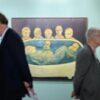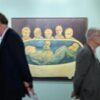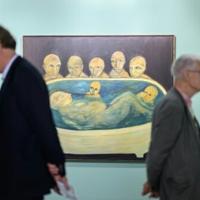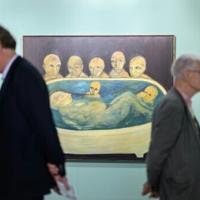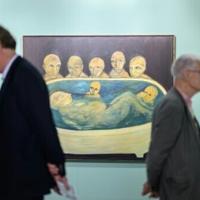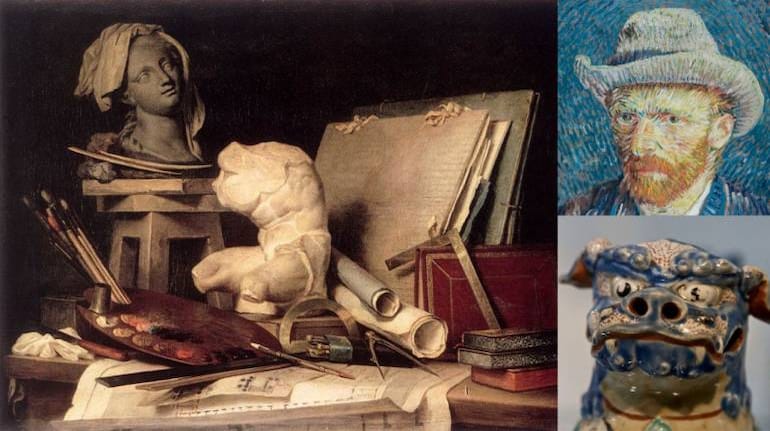
Seasoned collectors advise extra caution when buying works by well-known artists whose work already commands a high price in Indian and global art markets. Examples from India include MF Husain, SH Raza, VS Gaitonde, Ram Kumar, Krishen Khanna. (Images via Wikimedia Commons)
Not many know what Puneet Bhatia, the India head of TPG Capital, was thinking when he first laid eyes on the painting ‘Krishna with the Cows’ by artist Manjit Bawa. But everyone is aware of the police complaint he filed against solicitor Vishwang Desai and art dealer Rajesh Rajpal for selling him the fake painting. Apart from this painting, Bhatia purchased 10 more paintings – the sellers told him they were made by S.H. Raza and F.N. Souza, among other well-known artists – for a whopping sum of Rs 17.9 crores; all of which turned out to be fake.
Much like Bhatia, numerous art enthusiasts aspire to build their art collections featuring renowned contemporary and modern artists. As with most investments with potential for a large upside, the art market is plagued by counterfeits. Letters of authentication and seemingly unassailable provenance have been tempered with before.
To navigate these waters, we sought advice from artists, an art historian, and a seasoned artist-collector, to put together a set of golden rules for prospective art buyers. Here’s a list of what you should know before buying an artwork.
1. Delving into the artist’s work: Bengaluru-based artist Rekha Rao, who is the daughter of acclaimed artist and educator KK Hebbar, remembers Manjit Bawa’s style of working. “He never used a ruler or any geometrical instrument when doing circles and so on,” she says. “It takes a very experienced eye to spot the Manjit Bawa’s fakes.”
Most artists change their style over the years as they evolve from one series to the other. Sometimes they even change their signature. “My father changed the way he signed his name over the years, sometimes he would sign in both Hindi and English. As his daughter, I can corroborate the signature with the period of his work. This kind of knowledge one must have when studying the works of the artist they wish to buy.”
A deep academic knowledge of the artist’s oeuvre is needed when buying high-value art.
2. Due diligence and provenance scrutiny: Lawyer Ganesh Shivaswamy, a collector of Raja Ravi Varma chromolithographs and author of the six-volume series on Ravi Varma titled The Everlasting Imprint of which the first book The Shaping of the Artist was recently released, has experience in conducting art litigation.
“There is a big difference in the way people buy art to the way they buy immovable property,” he comments. “While an artwork could cost more than the immovable property, there is no due diligence done.”
Story continues below Advertisement
Shivaswamy has observed a peculiar inconsistency in the Indian art market. “The authenticity and provenance (the artwork’s history of ownership) are usually inversely related,” he says.
Generally, families who possess invaluable paintings sell the original works in secret using sketchy provenance. “Someone said they had ‘found’ the painting in the rubbish. One of them actually told me that he found the painting on a floating ship! In these cases, the paintings were original. When the provenance is grand and bombastic, it usually implies that they are not selling the painting but the provenance.”
Go through the provenance and do the due diligence which means going by the scientific way. “I would rely only on that.”
3. Utilizing scientific tools for art authentication: Technology is best at proving something is fake, but it is harder to declare something is the original. Still, it is the best way to verify and conclude the authenticity of a work.
Shivaswamy remembers a case where the painting in litigation was proven to be a fake Ravi Varma because of technology. One can look at the painting through X-Ray. “An examination via X-ray can tell the portions of a painting that have been retouched, the new portions of the painting and so on. It can also tell us about the materials used. For instance, Ravi Varma used lead white which will appear white under X-ray. The painting in litigation showed the presence of titanium white that was introduced in 1924. Since Ravi Varma died in 1904, it was conclusively proven as a fake.”
The other way to look at a painting is under UV light. From infrared reflectography to UV fluorescence, an expert uses these tools to detect discrepancy in the sketch done before the painting, forgery of signature and so on. A significant scientific tool is the surgical sampling which uses about 4-5 colours in paint samples (blue, green, yellow, crimson and white) to detect fakery.
“A fake Ravi Varma painting will be fully light or dark green in such a sampling.”
The problem that arises in this methodology is that some of the fakes have the same materials as the original. Shivaswamy notes that nowadays the fakes of Ravi Varma paintings are getting harder to tell. “People are selling unsigned works of artists like Sekhara Warrier as works by Ravi Varma. Since Warrier used the same materials as Ravi Varma, it gets harder to authenticate.”
4. Caution regarding renowned names: Prof R.H. Kulkarni, art historian and professor at College of Fine Arts, Karnataka Chitrakala Parishath, has been associated with the ASI Appeal Committee for the past 11 years to evaluate artworks. His rule for those buying art is simple: Be wary of buying works of those artists whose works command good market value even after their demise.
“Works of artists like MF Husain, SH Raza, FN Souza, or VS Gaitonde command great value in the art market,” he says. “Naturally, fake paintings of these artists abound in the market. I have so far not come across a fake of Abanindranath Tagore painting because there is not much demand.”
Kulkarni believes that dealers who sell fakes in the black market convince the buyer that they are buying a real work. The buyer then resells the painting in white because they believe the work is original. Fake paintings infiltrate the white market in this manner.
As an aside, Kulkarni mentioned some of the ‘beautifully rendered fakes’ he has come across. “With such talent, those artists could have come up with their own works!”
The fix: do your own research and purchase artists making a good name for themselves. Udaipur-based artist and collector Waswo X Waswo says, “It’s a gamble, but their work will probably increase in value, and since you started supporting them early, there is little chance that you’ll be buying a fake.”
5. Trustworthy galleries and documentation: Kulkarni underscores the role of reputable galleries in supporting genuine artists. “Such galleries have made modern art of India shine. Galleries like the Kumar Gallery in New Delhi have supported artists like Gaitonde, Ram Kumar, and Satish Gujral. When a buyer approaches such galleries, they will get original works with letter of authentication and a provenance certificate.”
Reputed galleries usually maintain a catalogue of the artists’ works which makes it easier to check the authenticity of a work. Bengaluru-based artist Gurudas Shenoy usually offers to give an authentication certificate with every painting he sells. “Although, some galleries prefer to give their own authentication certificate,” he says. “Apart from the authentication certificate and provenance, a buyer must preserve the bill because that too becomes a legal tender.”
Waswo advises buyers read the fine print of any contract they sign. “Make sure that the seller guarantees to reimburse the full amount of purchase if the work is proven to be a fake. Reputable galleries and auction houses wish to maintain their reputations.”
6. Cross-referencing the artist’s works: Before buying an artist’s work, Shenoy suggests that one should find out the galleries the artist was associated with and cross reference the work by looking at the artist’s biodata which usually lists the exhibitions the artist had participated in.
“My father, GS Shenoy, in his catalogue would include all the exhibitions meticulously,” he says. “Nowadays, one can go to social media and crosscheck the artist’s exhibitions and the works featured in them.”
Understanding the materials of the period when the painting was done is a great way to spot a fake. “Some of the original paintings of the previous century came in funny sizes unlike the standardized sizes of today,” Shenoy says. “So, look out for that.”
Check if the medium used is the correct one pertaining to the period in which the artist had painted the painting you are keen on. “It’s amazing how simple yet significant points like these can help in spotting out a fake.”
This post was originally published on this site be sure to check out more of their content

